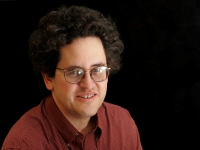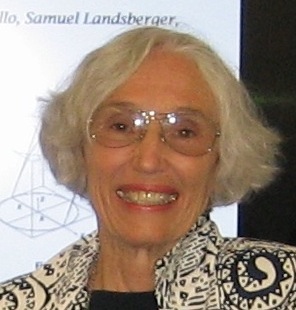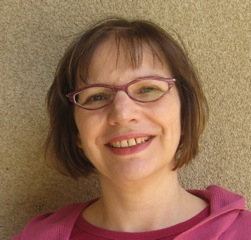Register
Online pre-registration is now closed. On-site registration will be available at the conference.
Fall 2016 SoCal-Nev Section Meeting
Annenberg Science Complex
California State University, Los Angeles
Saturday, October 22, 2016, 8:30-4:15
(Directions and Map)
Finalized Program
- 8:30-12:00 Registration
Courtyard, Annenberg Science Complex - 8:30-9:30 Refreshments
Courtyard, Annenberg Science Complex - 9:00-4:10 MAA Book Sale
Courtyard, Annenberg Science Complex
Organized by Richard Katz and Michael Hoffman, CSU Los Angeles - 9:30-11:30 Contributed Paper Session
View the call for papers
Salazar Hall (SH C240, SH C246, SH C255, SH C260, SH C264)
Organized by Eddie Tchertchian, Pierce Collge - 11:30-11:40 Transit time for going between Salazar Hall and Anneberg Science Complex
- 11:40-12:40 Invited Address by Shirley Gray, CSU Los Angeles
Fusion Mathematics
Annenberg Science Complex, Lecture Hall, ASCB 132 - 12:40-1:30 Lunch Break
Courtyard, Annenberg Science Complex - 1:30-2:30 Invited Address by Silvia Heubach, CSU Los Angeles
The Game Creation Operator
Annenberg Science Complex, Lecture Hall, ASCB 132 - 2:30-2:45 Section Business Meeting
Annenberg Science Complex, Lecture Hall, ASCB 132 - 2:45-3:00 Refreshments
Courtyard, Annenberg Science Complex - 3:00-4:00 Invited Address by John Baez, U.C. Riverside
The Answer to the Ultimate Question of Life, the Universe, and Everything
Annenberg Science Complex, Lecture Hall, ASCB 132
Directions and Maps
CSULA is located near the 10 Freeway and the 710 Freeway. Directions to the campus can be determined using their interactive direction map.
To find the Annenberg Science Complex and other campus locations, use the interactive campus map.
Parking: Parking Structure B (Level C) at the south end of campus is closest to the meeting. Enter either from Circle Drive or Paseo Rancho Castilla. You can buy a day pass for $6 at one of the machines. If you have a valid faculty/student parking pass from some other CSU campus, you can park for free in faculty /student parking at CSULA.
There is a campus information booth at the intersection of Circle Drive and Paseo Rancho Castilla.
Register
Online pre-registration is now closed. On-site registration will be available at the conference.
Registration Fees
| Registration only | |
| Nonmember | $50 online ($55 on-site) |
| MAA Member | $45 online ($50 on-site) |
| Student | $15 online ($20 on-site) |
Box Lunch Each lunch includes a sandwich, chips and either water or soft drink. The sandwich choices are: Roasted Turkey, Roast Beef, Tuna Salad, Roasted Vegetables, or Caprese (Tomato/Basil/Mozzarella) |
|
| Add lunch | $11 |
On-site registration will be available for the meeting, but will be $5 more than the pre-registration charge.
Register on-line
Click here to register on-line and pay by credit card (deadline is Monday October 17th by 5:00pm).
John BaezUC Riverside |
John Baez is professor of mathematics at the University of California Riverside. His Internet column “This Week’s Finds” dates back to 1993 and is sometimes called the world’s first blog. He used to work on higher category theory and quantum gravity. In 2010, concerned about climate change and the future of the planet, he switched to working on slightly more practical topics, such as a general theory of the networks that appear in human-engineered and biological systems. |
The Answer to the Ultimate Question of Life, the Universe, and Everything
In The Hitchhiker's Guide to the Galaxy, by Douglas Adams, the number 42 is revealed to be the "Answer to the Ultimate Question of Life, the Universe, and Everything". But he didn't say what the question was! I will reveal that here. In fact it is a simple geometry question, which turns out to be related to the mathematics underlying string theory.
Shirley GrayCSU Los Angeles
Teaching Award Recipient
 |
Shirley claims she learned three important things in high school: music, typing and reading two-column Euclidean proof. She was blessed with a grandmother who loved genealogy, parents with university degrees and teachers who felt they were educating their students for life. All combined to place her in a 1950s university course entitled “Theory of Equations.” The professor happened to remark that an interesting derivation had first been posed by a man named “Taylor.” As there were many Taylors in her family, Shirley felt that maybe she should pursue mathematics as typing did not have a future and music presented few opportunities in a small Kentucky town. At about this time she met her husband and father of their three children. For three generations there have been teachers in her family. She feels there is no nicer way to enjoy life than to keep an interest in research and publishing. To students in the audience, she advises never to fret over topics you do not like. Lead with your strengths. To faculty, she encourages all to build a professional network of friends. In Shirley’s case, this has been the MAA and IHMT HOM-SIGMAA. Finally, she urges all in the audience to go home and thank the technical staff supporting our efforts. We are already experiencing the rise of Fusion Mathematics. |
Fusion Mathematics
No treatise of mathematics has attracted more international attention in the past decade than the Palimpsest of Archimedes. The 1998 auction at Christie's, followed by collaborative work centered at the Walters Art Museum led to traveling museum exhibits, newspaper articles, television specials, and dozens of presentations. Mathematicians and other scholars attracted a new and significant audience. The singed, battered, faded, mildewed, damaged 10th century manuscript - the world's oldest copy of The Method of Archimedes - sold for $2 million "under the hammer.'' In the true Archimedean experimental tradition, my team of students, staff and faculty decided to look not retrospectively at the content of propositions in The Method but rather in terms of 21st century mathematics and technology. “We believe we participated in every scholar's quest to have a Eureka moment - we found the Golden Ratio in our attempts to image the footprint of Archimedes.” This discovery led to several publications and a Wikipedia article. But perhaps more importantly, our work in simultaneously embracing computer graphics, computer science, pure mathematics and 3-D printer modeling may reap huge benefits for future research in a new field that we call fusion mathematics.
Silvia HeubachCSU Los Angeles |
Originally from Germany, Silvia Heubach came to USC for a year of study, but then decided to stay and complete a Ph.D., writing a thesis on a stochastic model for the movement of white blood cells. She joined Cal State LA in 1994, and has been active in both research and curricular development. Her interest in mathematical biology led to a redesign of the mathematics sequence required for life science majors in 2010, supported by a multi-year NIH grant. She also received an earlier NSF grant for the development of a general education course on modeling. Her research focus moved from mathematical modeling to enumerative combinatorics, and more recently, to combinatorial games. She is the co-author of Combinatorics of Compositions and Words and has contributed two chapters on probability and statistics for Concepts in Bioinformatics and Genomics. Her teaching, research, and service were recognized by the Cal State LA Outstanding Professor award in 2000 and the Cal State LA Distinguished Women award in 2013. Silvia Heubach enjoys working with students on combinatorial games and solving NYT crossword puzzles with her husband. |
The Game Creation Operator
Combinatorial games are games in which both players have full knowledge of the available moves – no chance is involved! We will focus on vector subtraction games, in which two players alternately remove tokens from a number of stacks. The well-known game of NIM is an example this type of combinatorial game. For vector subtraction games, the allowed moves are given as a set of vectors that indicate how many tokens can be removed from the respective stacks. Game positions are described by vectors listing the respective stack heights, so moves and positions have the same structure. This allows us to define a game creation operator that generates a new game by selecting specific positions in the current game and making them the moves in the new game. We will explore properties of this operator and the behavior of the sequence of games it creates for vector subtraction games on any number of stacks, and give more specific results for games on one and two stacks.
Contributed Paper Session
Faculty and students (undergraduate and graduate) are invited to submit short proposals for 15-minute talks in the Contributed Paper Session of the Fall 2016 Meeting, taking place on Saturday, October 22 at CSULA.
This session accepts contributions in all areas of mathematics, including research and pedagogy, and all complete proposals will be considered.
The selection of talks will be based on interest to the expected audience, on common themes with other submissions, and on scheduling constraints. Since space and time are limited, acceptance may be prioritized based on the status of the speaker; first undergraduates (U), then graduate students (G), retirees (R), and faculty (F) in order of rank (lower rank has higher priority).
Submissions should contain a title, an abstract (not to exceed 150 words, should be suitable for inclusion in the conference program), the author(s) of the paper (with an indication of who the presenter will be), the desirable mathematical background of the audience, and any special presentation display needs(*).
Do include in each submission the institutional affiliations of all authors if they have any, as well as their current status (U, G, R, or F). Select up to two of the categories below to indicate your main theme:
Education / Pedagogy;
History and Philosophy of Mathematics;
Interdisciplinary Topics;
Probability and Statistics;
Geometry and Linear Algebra;
Analysis;
Number Theory;
Graph Theory and Combinatorics;
Algebra and Topology;
Applied Mathematics;
Other Assorted Topics.
(*) Each room will have a built-in projector and a computer. If you require a document camera, want to use your own computer, or any other presentation setup, please say so in your proposal and we will work with you to obtain one.
Ideally abstracts should be submitted in LaTeX format, with an accompanying PDF file. If you do not use LaTeX, please submit a Text document together with a PDF file. Please email all submissions to Eddie Tchertchian (tchertea@piercecollege.edu).
The submission deadline for Contributed Papers is 12 noon on Friday, October 7, 2016.
